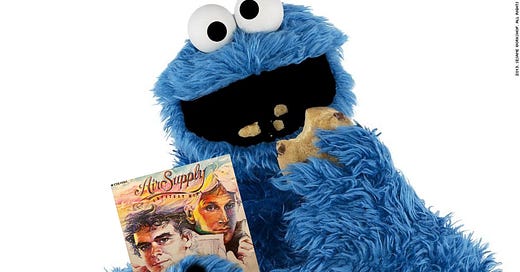The classic monsters are, of course, Frankenstein, The Wolfman, and Dracula…
(Oh, sure, you can add in the Mummy and the Creature from the Black Lagoon if you want, but no one dresses as them for Halloween.
Well, maybe the Mummy, if you’re not planning on dancing or walking very fast all night, but the Fish-Man would take professional grade make-up work and seems like a really uncomfortably hot costume, even for a brisk October night.)
…these are monsters that live in black and white worlds, in times far from our own, whose stories embrace what it means to be human, as each of us struggle to navigate an often unforgiving world.
So I mean, they’re ok, but in my opinion, the best monster (and the very FIRST for my generation) is pure bright cobalt blue.
In 1969 Jim Henson premiered a fuzzy puppet on the new educational show he was producing for public television. After a bit of character development, that puppet earned a name - Cookie Monster. I was 3 years old, so this was kismet, synchronicity, a meet-cute through our console tv as my wide little eyes met his great big googly ones. He liked some of the same things I liked, he was learning the alphabet (same as I was!)…if this was a monster, then I was all for ‘em.
This is where I first learned the word “monster”: a fuzzy lovable talking pile of fluff. Full disclosure - I’m with Grover: his curious optimism and entirely boneless arms soothe me to this day, but all of the monsters of Sesame Street are an amazing demonstration of difference without threat, acceptance without fear, because the children on the program spoke to them and weren’t afraid, so neither was I. On Sesame Street, to be a monster was to be open and vulnerable, unique and authentic, honest and courageous.
Then there was Godzilla. Not the computer rendered mutant horror dinosaur of today, but a middle-aged man dressed in a 200 pound rubber suit. The original TOHO movies (on after school TV) all ended with children in short panted school uniforms waving and thanking Godzilla, most often for shooing away another giant creature with a grudge of some kind. This monster fought other monsters - the enemy of my enemy was my friend.
It went downhill after that. Cinematic technology made it easy to create more horrifying visuals, and filmmakers seemingly steeped in nihilistic ennui began to crank out more horrific plots. Now the monster was us, the creatures were we; zombies and aliens and demons and serial killers. Dread itself became the star of all these films, served at a bargain price since you got to take so much of it home with you, like the uneaten popcorn in that extra large bin you decided to buy.
I had felt compassion for the Frankenstein monster. He didn’t ask for all that. The Wolfman was an unwilling victim of a leash law violation, and Dracula was a guy with a food allergy dealing with a houseful of uninvited guests. Even Godzilla was just chillin’ until Mothra and Mecha-Godzilla decided to bring all that noise.
But I could never dredge up sympathy for these new disappointed killing machines, unsatisfied with their summer camps, neighborhood clubs, or high school experiences. They weren’t monsters - they were maniacs, and there seemed to be an endless supply of them.
Which brings me to Air Supply.
They were a soft rock duo from Australia who became super famous in the 1980’s for songs about love. We had a lot of love songs on the radio back then, in every style of music, but Air Supply created tunes you couldn’t help but memorize - power rotation tone poems.
Our current popular music is filled to the brim with virulent break-up songs, but the music of Air Supply made love seem like something wonderful, not only to be survived or afraid of.
They did lean a bit on the clingy side, but so did the work of Chicago, Lionel Richie, Foreigner, Journey: each offering a selection of hits fully appropriate to be “Our Song” to any couple.
But they couldn’t be written today, as through a contemporary lens, they all seem a bit…suspicious; the syrupy lyrics now read as obsessive, giving an “I just wrote these lyrics with letters I cut out of magazines” kind of vibe.
To be fair, I did try singing one of their songs to my date at a high school dance, soon realizing that the words,“you're every woman in the world to me…you're my fantasy, you're my reality…you're everything I need…” were a bit much for a 9th grade second date.
My point is: I don’t think that only movies have gotten scarier - EVERYTHING has: love, bread (well, I’m allergic to both gluten and dairy, so a grilled cheese sandwich looks like a ninja throwing star to me), the sun, traveling, laundry detergent (apparently we shouldn’t eat it, even if it’s delicious), each other, ourselves...
The stories of Frankenstein, Wolfman, and Dracula span all the core conflicts - person vs. nature, person vs. person and the hardest of all, person vs. self. All three characters are in circumstances beyond their control, doing the best they can with where they are with very little help, facing ultimately (in all three cases) the insurmountable distraction of torches and pitchforks.
But they’re not maniacs.
I mean, we all have days we just don’t feel put together right, or our hair seems to have a life of its own, or we eat something we know we shouldn’t.
In a world that’s gone from monochromatic creatures to 4K maniacs, each of us has the choice to still be open and vulnerable, unique and authentic, honest and courageous.
You know. Monsters.














Share this post